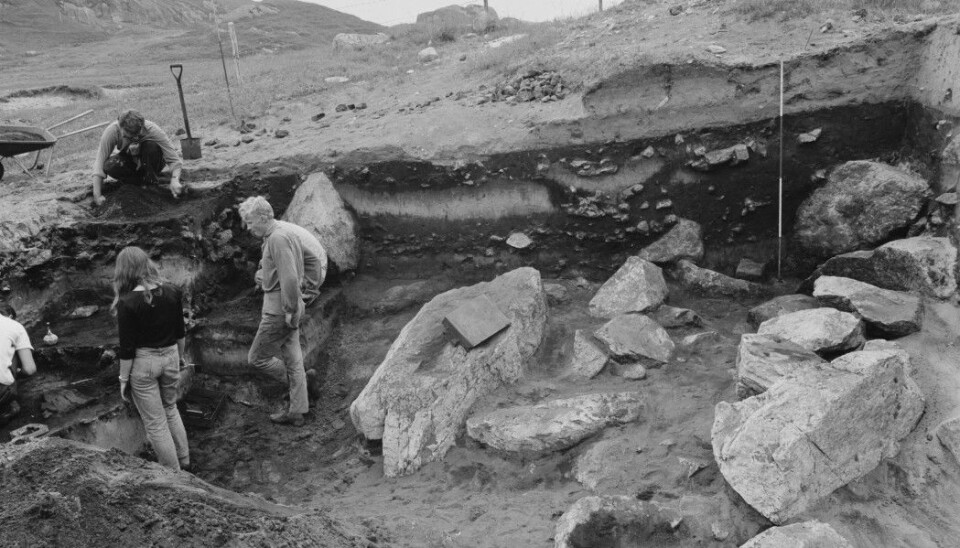
First Stone Age farmers in Norway "gave up" after short period of time
The end of the Stone Age, or Neolithic, was a time of major change. People tried their hand at farming for the first time. Researchers have now re-analysed findings throughout southern Norway from this time period.
Agriculture came to Scandinavia for the first time during the final stages of the Late Neolithic period, around 3900 to 1800 BCE.
But there are still so many unanswered questions about life in Norway at the time.
How did people live? Were they influenced by other peoples in Europe? These are the kinds of questions explored by Svein Vatsvåg Nielsen and colleagues from the University of Oslo's Museum of Cultural History in a new study published in the Journal of Anthropological Archaeology.
"We opted to use a lot of archaeological data at once to see if it could tell us anything about changes in the population and in the intensity of human activity," he says.

Nielsen and his colleagues have studied data from previous excavations in the eastern, central, and western parts of Norway.
"In recent years the methods used to analyse large datasets have undergone major developments. Computer program and computer power development make it possible for us to look at the old data in a new way," says Nielsen.
Read More: Nordic Stone Age diet was dominated by fish
Arrowheads and nutshells
They studied 643 samples, which were previosuly dated using radiocarbon, as well as archaeological objects from around 200 sites around Norway.
The samples included fireplaces, cooking pits, building remains, and burnt nutshells. Studying the distribution of radiocarbon dated material allowed them to analyse populaiton changes during the Late Neolithic.
Migration wave spread northward from Middle East
The first people who started farming came from the Middle East around 11,500 years ago, where they began to keep animals and grow crops.
"An old theory states that people who farmed, had more children and more stable lives than people who lived as hunter and gatherers," says Nielsen.
Some residents emigrated, and some may have fled due to overcrowding pressures.
"According to this theory, the migrations led to a very slow wave across Europe. We wanted to see if we could find traces of this wave in Norway. So it made sense for us to compare eastern Norway with the surrounding regions," Nielsen says.
The oldest farming culture in Scandinavia probably became established around 3,900 BCE. Norway was rather late in the game, but researchers believe they can also see traces of this 'wave' reaching Norway at the beginning of the Late Neolithic.
The indications are clearest in Eastern Norway, where a blossoming of activity indicates the arrival of more people in the area. Whether local hunters learned a few tricks from their neighbours to the south, or migrants displaced the fisher culture, is hard to say. Future DNA analysis of skeletons may eventually provide some answers.
"We think this increased activity was due to the first farming societies that grew up around and north of the Oslo Fjord during this period," Nielsen says.
However, direct evidence of agriculture does not exist in the archaeological material.
"The soil in Eastern Norway is very acidic and the traces of cultivation have been poorly preserved. It's been ploughed over for hundreds of years so any old traces have mostly disappeared," he says.
The distribution of a certain type of axe suggests that farming was taking place in Eastern Norway during this period.
Read More: Mysterious Stone Age rock shows up on Danish Island
Fishing settlements dotted along the coast
But while people eslewhere in Europe had gotten the hang of cultivating crops and keeping livestock, the first farmers in Norway appear to have given up relatively early. They stopped growing crops after a relatively short period of time and returned to hunter-gatherer-fisher lifestyle.
The first period of apparent population growth, was followed by a long period of 1,500 years with less activity and a subsequent population decline. Whether the challenges were related to the climate in Norway or other factors is unclear.
However, settlements in the coastal areas grew and were strongly linked to the sea, where food was plentiful.
Characteristic ceramic objects tell the story of a maritime culture.
Nielsen says the arguments have gone back and forth as to why people returned to a fishing culture or gave up farming. Some think its an obvious way to live, given the country's huge coastal resources. On the other hand, why would the people who introduced agriculture end it? Espeically when they were probably familiar with it in northern Germany and Denmark.
Some hardy, or perhaps hard-headed, types also stayed in the mountains and along the coast of central Norway. But there are even fewer findings in these places.
Big changes towards the end of Late Neolithic
Towards the end of the Late Neolithic period, researchers again saw changes in the population.
"The settlement pattern changes very clearly when we approach 5,300 years ago. Coastal sites fall out of use, and long houses and grains begin to show up. We start to see a type of settlement that we recognise from the Bronze Age and Iron Age," says Nielsen.
Farming society began to take shape. A little later, immigrants from the Bell Beaker culture along the coast came and brought new technology, customs, and culture. The Bronze Age was at hand.
Studying all of the Late Neolithic archaeolgical sites throughout southern Norway collectively, confirms the results of previous studies: Agriculture seems to have been introduced in Norway twice, and the second time it came to stay.
"We think our results show that major changes in the population size occurred during the Late Neolithic, which in itself is very interesting. We can't count people so we have to use other inputs to these questions. If you accept this premice, then we believe we have data that confirms this," says Nielsen.
----------------
Read the Norwegian version of this article at forskning.no



































